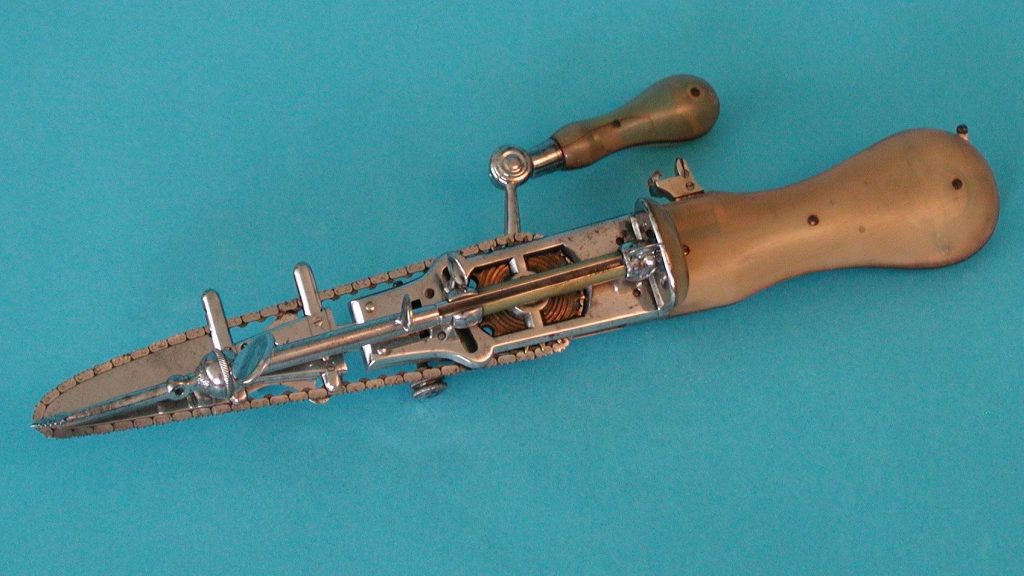 is no secret that modern medicine has advanced significantly, but did you realize that chainsaws were first created to help in childbirth? Since the 1700s, the chainsaw’s history has advanced quickly. Let’s examine what inspired this development in more detail.
is no secret that modern medicine has advanced significantly, but did you realize that chainsaws were first created to help in childbirth? Since the 1700s, the chainsaw’s history has advanced quickly. Let’s examine what inspired this development in more detail.
Large babies were challenging for mothers to deliver vaginally before C-sections. Cesarean sections, sometimes known as C-sections, involve the surgical expulsion of the infant from the uterus.
This is typically necessary, according to Mayo Clinic, if complications with the baby’s passage through the birth canal are anticipated or if problems develop in the final stages of pregnancy, such as delayed labor or a disturbed baby.
Why Were Chainsaws Invented?
C-sections weren’t yet used in the 1700s. Baby and/or mother deaths could occur as a result of babies being stuck in the delivery canal. Therefore, a new solution called symphysiotomy was invented.
To understand the reason why chainsaws were invented, we need to go back to the late 18th century when two Scottish doctors, John Aitken and James Jeffray, designed the first chainsaw in 1780. At the time, cesarean sections were a dangerous and often deadly procedure, with mothers having a very low chance of survival. In an attempt to make the operation quicker and more efficient, the doctors began experimenting with a chainsaw-like device that could cut through bone quickly and cleanly.

A symphysiotomy involves manually widening the pelvis by removing cartilage from it.
The place where the cartilage will be removed can be seen in the above image as the black area with the number 5. To accommodate the baby after removal, the pelvis would be widened.
You could be picturing the kind of chainsaw used by lumberjacks or bad guys in horror films. Rest assured; the early chainsaws weren’t as big.

First Step Towards Modern Surgery
The original chainsaw was much more compact. It had the name osteotome. The word’s origins are in the Greek words for “bone” and “sliced,” which was pretty appropriate.
It consisted of a small chainsaw-like blade attached to a handle. It was designed to cut through bone and cartilage quickly and efficiently, reducing the amount of time it took to perform a cesarean section. However, the device was never used for this purpose, as doctors soon realized that it was too dangerous and imprecise for surgical use.
Cutting the pelvic bone was quicker, simpler, and more accurate thanks to the serrated blade. Throughout the 19th century, this tool was frequently used to aid in childbirth and other treatments that needed cutting through bone.
However, as time went on and (luckily) medical techniques improved, sanitation and anesthetic took center stage.
For good reason, symphysiotomies are no longer utilized during labor. They were a messy procedure that frequently hurt the woman in the long run. As the treatments were frequently performed without anesthetic and might be challenging to recover from, this harm was both physical and mental.
The cruel procedure, became obsolete once doctors could properly administer anesthetic and the C-section became safer.
Even though the use of chainsaws in surgery began to decline, many people soon recognized that if they could cut through bone, they could certainly do the same with other tough materials, including wood.
Despite its failure as a surgical tool, the chainsaw found a new purpose in the logging industry. In the early 20th century, as the demand for timber increased, loggers needed a more efficient way to fell trees and cut them into logs. The chainsaw proved to be the perfect tool for the job, allowing loggers to out through trees quickly and with minimal effort.
Samuel Bens applied for the first electric chainsaw patent in 1905 with the intention of felling enormous redwood trees for building purposes.
Multipurpose Tool
Over the years, chainsaws have become increasingly popular as a tool for forestry, construction, and landscaping. They are now available in a wide range of sizes and styles, from small electric models for home use to large, gasoline-powered models for commercial applications. Chainsaws have also become synonymous with horror movies and slasher films, thanks to their intimidating appearance and association with violence and mayhem.
Despite their association with horror movies, chainsaws remain an important tool for many industries, including forestry, construction, and landscaping. They are used for a variety of tasks, such as cutting down trees, trimming branches, and carving wood. Chainsaws are also used by firefighters to clear paths through dense forests and by rescue workers to remove debris after natural disasters.
The Impact of Chainsaws Across the World
In recent years, there has been growing concern about the environmental impact of logging and deforestation. The use of chainsaws has been criticized for contributing to the destruction of forests and the depletion of natural resources. In response to these concerns, some companies have developed eco-friendly chainsaws that use less fuel and produce fewer emissions.
Aside from their practical applications, chainsaws have also become a cultural icon. They have been featured in countless movies, television shows, and video games. The image of a chainsaw-wielding maniac has become a staple of the horror genre, with films such as “The Texas Chainsaw Massacre” and “Evil Dead” cementing the chainsaw’s reputation as a weapon of terror.
Despite their fearsome reputation, chainsaws are safe tools when used properly. It is important to follow safety guidelines and wear protective equipment such as gloves, eye protection, and hearing protection. Chainsaws should be regularly maintained and kept sharp to prevent accidents.
In conclusion, the chainsaw may have been invented for a disturbing reason, but it has become an important tool in many industries and a cultural icon in its own right. While its origins as a medical tool for cesarean sections are little known, its practical applications in the logging, construction, and landscaping industries cannot be underestimated. As technology continues to evolve, it will be interesting to see how the chainsaw adapts and evolves to meet the changing needs of society.
Avid Writer with invaluable knowledge of Humanity!
Upcoming historian with over 30 million views online.
“You make your own life.”





